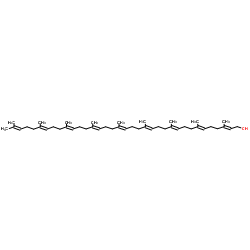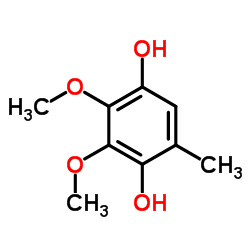ubiquinone-9

ubiquinone-9 structure
|
Common Name | ubiquinone-9 | ||
|---|---|---|---|---|
| CAS Number | 303-97-9 | Molecular Weight | 795.227 | |
| Density | 1.0±0.1 g/cm3 | Boiling Point | 826.8±65.0 °C at 760 mmHg | |
| Molecular Formula | C54H82O4 | Melting Point | 41-43ºC | |
| MSDS | Chinese USA | Flash Point | 314.4±34.3 °C | |
Use of ubiquinone-9Coenzyme Q9, a nine isoprenyl group-containing member of the ubiquinone family, is a normal constituent of human plasma. |
| Name | ubiquinone-9 |
|---|---|
| Synonym | More Synonyms |
| Description | Coenzyme Q9, a nine isoprenyl group-containing member of the ubiquinone family, is a normal constituent of human plasma. |
|---|---|
| Related Catalog | |
| Target |
Human Endogenous Metabolite |
| In Vitro | Both CoQ9 and CoQ10 are equally cardioprotective, as evidenced by their abilities to improve left ventricular performance and to reduce myocardial infarct size and cardiomyocyte apoptosis. HPLC analysis reveals that a substantial portion of CoQ9 has been converted into CoQ10[1]. CoQ10 and CoQ9 are components of themitochondrial respiratory chain in mammals and can regulate some mitochondrial proteins/functions. Soybean, corn, and rapeseed oils are very rich sources of CoQ10, whereas CoQ9 has been found in high concentrations in corn oil[2]. |
| In Vivo | The lack of a functional CoQ9 protein in homozygous CoQ9 mutant (CoQ9(X/X)) mice causes a severe reduction in the CoQ7 protein and a widespread CoQ deficiency and accumulation of demethoxyubiquinone. The deficit in CoQ induces a brain-specific impairment of mitochondrial bioenergetics performance, a reduction in respiratory control ratio, ATP levels and ATP/ADP ratio and specific loss of respiratory complex I. These effects lead to neuronal death and demyelinization with severe vacuolization and astrogliosis in the brain of CoQ9 (X/X) mice that consequently die between 3 and 6 months of age[3]. |
| References |
| Density | 1.0±0.1 g/cm3 |
|---|---|
| Boiling Point | 826.8±65.0 °C at 760 mmHg |
| Melting Point | 41-43ºC |
| Molecular Formula | C54H82O4 |
| Molecular Weight | 795.227 |
| Flash Point | 314.4±34.3 °C |
| Exact Mass | 794.621338 |
| PSA | 52.60000 |
| LogP | 18.89 |
| Vapour Pressure | 0.0±3.0 mmHg at 25°C |
| Index of Refraction | 1.525 |
| Storage condition | -20°C |
CHEMICAL IDENTIFICATION
HEALTH HAZARD DATAACUTE TOXICITY DATA
|
| Personal Protective Equipment | Eyeshields;Gloves;type N95 (US);type P1 (EN143) respirator filter |
|---|---|
| Safety Phrases | S22 |
| RIDADR | NONH for all modes of transport |
| RTECS | DK4786000 |
|
A nuclear role for the respiratory enzyme CLK-1 in regulating mitochondrial stress responses and longevity.
Nat. Cell Biol. 17 , 782-92, (2015) The coordinated regulation of mitochondrial and nuclear activities is essential for cellular respiration and its disruption leads to mitochondrial dysfunction, a hallmark of ageing. Mitochondria commu... |
|
|
Rapid high performance liquid chromatography-high resolution mass spectrometry methodology for multiple prenol lipids analysis in zebrafish embryos.
J. Chromatogr. A. 1412 , 59-66, (2015) The analysis of lipid molecules in living organism is an important step in deciphering metabolic pathways. Recently, the zebrafish has been adopted as a valuable animal model system to perform in vivo... |
|
|
Effects of various squalene epoxides on coenzyme Q and cholesterol synthesis.
Biochim. Biophys. Acta 1841(7) , 977-86, (2014) 2,3-Oxidosqualene is an intermediate in cholesterol biosynthesis and 2,3:22,23-dioxidosqualene act as the substrate for an alternative pathway that produces 24(S),25-epoxycholesterol which effects cho... |
| ubiquinone-9 |
| Ubidecarenone impurity D |
| Coenzyme Q9 |
| Coenzyme Q9 |
| Ubiquinone Q(sub 9) |
| CoQ(sub 9) |
| Coenzyme Q(sub 9) |
| 2,3-dimethoxy-6-methyl-5-nonaisoprenoid-1,4-benzoquinone |
| 2,3-Dimethoxy-5-methyl-6-[(2E,6E,10E,14E,18E,22E,26E,30E)-3,7,11,15,19,23,27,31,35-nonamethyl-2,6,10,14,18,22,26,30,34-hexatriacontanonaen-1-yl]-1,4-benzoquinone |
| All-Trans Coenzyme Q9 |
| 2,3-dimethoxy-5-methyl-2-<(all-E)-3',7',11',15',19',23',27',31',35'-nonamethylhexatriaconta-2',6',10',14',18',22',26',30',34',nonaenyl>cyclohexa-2,5-dien-1,4-dion |
| CoQ9 |
| ubiquinone Q9 |
| 2,5-Cyclohexadiene-1,4-dione, 2,3-dimethoxy-5-methyl-6-[(2E,6E,10E,14E,18E,22E,26E,30E)-3,7,11,15,19,23,27,31,35-nonamethyl-2,6,10,14,18,22,26,30,34-hexatriacontanonaen-1-yl]- |
| 2,3-dimethoxy-5-methyl-6-[(2E,6E,10E,14E,18E,22E,26E,30E)-3,7,11,15,19,23,27,31,35-nonamethylhexatriaconta-2,6,10,14,18,22,26,30,34-nonaenyl]cyclohexa-2,5-diene-1,4-dione |
| Ubidecarenone Related Compound A |
| Ubiquinone-45 |
| Q-9 Ubiquinone-45 Ubiquinone-9 |
 CAS#:13190-97-1
CAS#:13190-97-1 CAS#:3066-90-8
CAS#:3066-90-8 CAS#:5677-54-3
CAS#:5677-54-3 CAS#:110582-10-0
CAS#:110582-10-0 CAS#:52610-77-2
CAS#:52610-77-2 CAS#:83626-22-6
CAS#:83626-22-6 CAS#:303-98-0
CAS#:303-98-0
